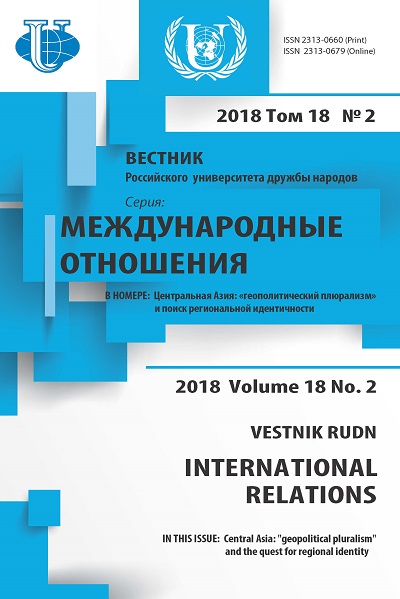RUSSIAN-ISRAELI RELATIONS: THE ROLE OF THE RUSSIAN-SPEAKING COMMUNITY OF THE STATE OF ISRAEL
- Authors: Moshkova T.D.1
-
Affiliations:
- Saint Petersburg State University
- Issue: Vol 18, No 2 (2018): Central Asia: “geopolitical pluralism” and the quest for regional identity
- Pages: 387-399
- Section: BILATERIAL RELATIONS
- URL: https://journals.rudn.ru/international-relations/article/view/18888
- DOI: https://doi.org/10.22363/2313-0660-2018-18-2-387-399
Cite item
Full Text
Abstract
The article is devoted to the study of the large and actively developing community of Israel - the “Russian street” - and its influence on the relations between Israel and Russia. The author considers such aspects of the topic as: the differences of the “Great Aliyah” of the 1990’s from the first wave of repatriation of the 1970’s and the factors that formed the unique “Russian-Jewish” identity among the representatives of the “Russian street”, the political and economic potential of “Russian Israel”, the main areas of cooperation between the two states and the role of the “Russian” community in this cooperation. A specific feature of the work is the use of the hermeneutic approach which is expressed in the author’s desire to comprehend the unique identity of a specific cultural community and to identify a number of factors that have decisively influenced the formation of a unique identity of such a community in a specific historical period. The author also resorts to general scientific procedures and operations, such as analysis and synthesis, inductive and deductive methods. The scientific novelty of the research is the author’s attempt to give a forecast concerning the possibility of forming a pro-Russian economic lobby among Israeli businessmen in the future as well as a forecast concerning the return of our former compatriots to Russia with the goal of developing the domestic high-tech industry. The main conclusion of the study is the following: if politically the community does not have a decisive influence on the actions of the Israeli authorities, then economically, it unequivocally contributes to strengthening economic ties between Israel and Russia. Russia’s initiatives to develop various forms of economic, cultural and media cooperation can give impetus to the growth of the influence of the Russian-speaking community.
About the authors
Tatiana Dmitrievna Moshkova
Saint Petersburg State University
Author for correspondence.
Email: tata.midge@gmail.com
postgraduate student of Faculty of International Relations of the Saint Petersburg State University
References
- Adler Sh. Israel’s Absorption Policies since 1970’s. In: Russian Jews on the Three Continents. Migration and Resettlement. Ed. by N. Lewin-Epstein, Y. Ro’i, P. Ritterband. London: Routledge, 1997, p. 135-144.
- Donnitsa-Shmidt, S. (2007). Language preservation or development? The Russian language of returnees from the CIS in Israel. Ed Kha-ul'pan kha-khadash, 85, 57-64. (In Russ.).
- Fedorchenko, A.V. (1998). The economy of the resettlement society (the Israeli model). Moscow: Institute for Study of Israel and the Middle East. (In Russ.).
- Feldman, E. (2003). “Russian” Israel: between the two poles. Moscow: Market DS. (In Russ.)
- Horowitz, T. (1998). Value-Oriented Parameters in Migration Policies in the 1990’s: The Israeli Experience. International Migration, 4, 514-526
- Khanin, V. (2004). “Russians” and power in modern Israel. Moscow: Institute for the Study of Israel and the Middle East. (In Russ.).
- Khanin, V. (2008). “Russian” lobby in the Israeli policy 1996-2006. Bulletin of the Hebrew University, 12 (30), 98-116. (In Russ.).
- Khanin, V. (2014). “Third Israel”: Russian-speaking community and political processes in the Jewish state at the beginning of the XXI century. Moscow: Institute of the Middle East. (In Russ.).
- Kupovetskiy, M. (2000). Yehudei mi hamoatsot karov brit: ohlusiya ve haluka geographi [Jews of the former USSR: population and geographical distribution]. Yehudei mi hamoatsot be parashat drakhim [Jews of the USSR at the crossroads], 4, 128-135. (In Hebrew)
- Leshem, E. (2007). The Russian Aliya in Israel: Community and Identity in the Second Decade. Lanham: Rowman and Littlefield Publ. Inc
- Leshem, E. & Lissak, M. (1999). Development and Consolidation of the Russian Community in Israel. Jerusalem: Magnes Press
- Leshem, E. & Lissak, M. (2000). Gibush shel ha kehila rusit be Israel [Formation of the “Russian” community in Israel]. Yehudei mi hamoatsot be parashat drakhim [Jews of the USSR at the crossroads], 4. (In Hebrew)
- Lissak, M. & Leshem, E. (1995). The Russian Intelligensia in Israel: Between Ghettoization and Integration. Israel Affairs, 2, 22-23
- Mar’yasis, D.A. (2015). Experience in building the economy of innovation. An example of Israel. Moscow: IOS of RAS. (In Russ.)
- Morozov, V.M. (2003). Returnees from the USSR / Russia-CIS and their influence on the political, social and economic life of the State of Israel. Moscow: Institute for the Study of Israel and the Middle East. (In Russ.)
- Morozov, V.M. (2015). “Russian” Israel: the impact of repatriates on Russian-Israeli relations. Moscow: MGIMO-University. (In Russ.)
- Niznik, M. (2003). Features of cultural integration of immigrants from the USSR / CIS in Israel. Diaspora, 1, 49-60. (In Russ.)
- Niznik, M. (2010). Russian Language in Israel - Is it Half Alive or Half Dead? Paper, presented to the “National Challenge - the Third Ashdod Conference on Aliya and Absorption”. Ashdod
- Remennik, L. (2008). “Russians” Israelis through the eyes of a sociologist: culture and way of life. Moscow: IOS RAS Natalis. (In Russ.)
- Vardimon, D. (2003). Yahasei gomlin shel rashii ve lokali mosadot be Israel be zira klitat aliyah [Relations between central and local authorities in Israel in the sphere of absorption of new immigrants]. Ramat-Gan: Universita Bar-Ilan (Ramat Gan: Bar-Ilan University). (In Hebrew)
- Zvyagelskaya, I.D., Karasova, T.A. & Fedorchenko, A.V. (2005). The State of Israel. Moscow: IOS RAS. (In Russ.)











